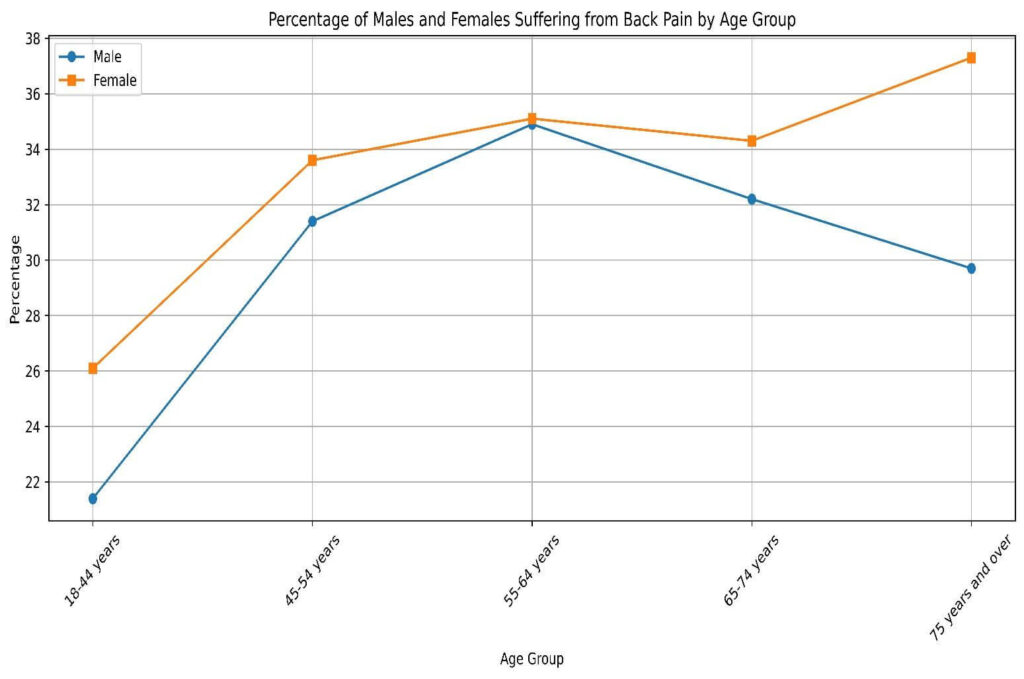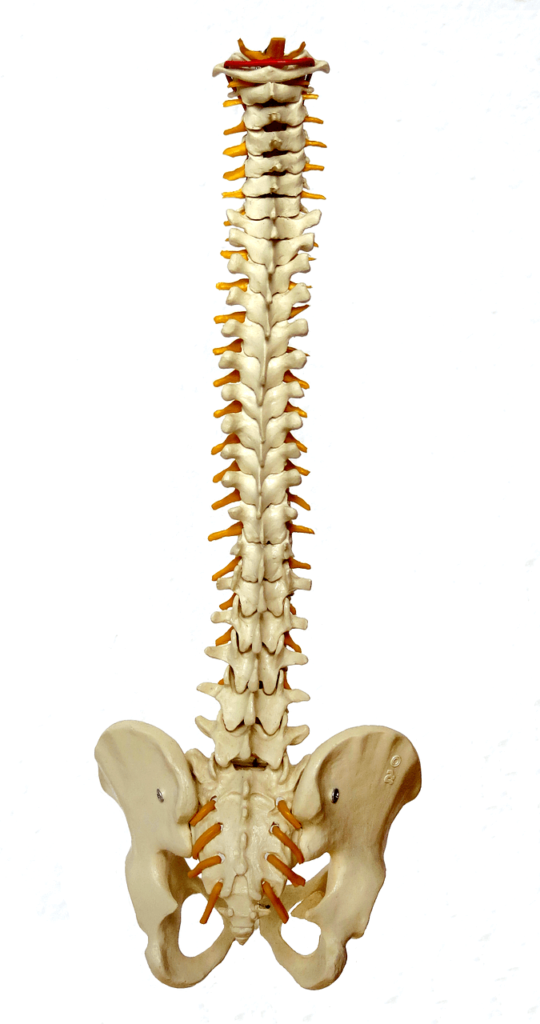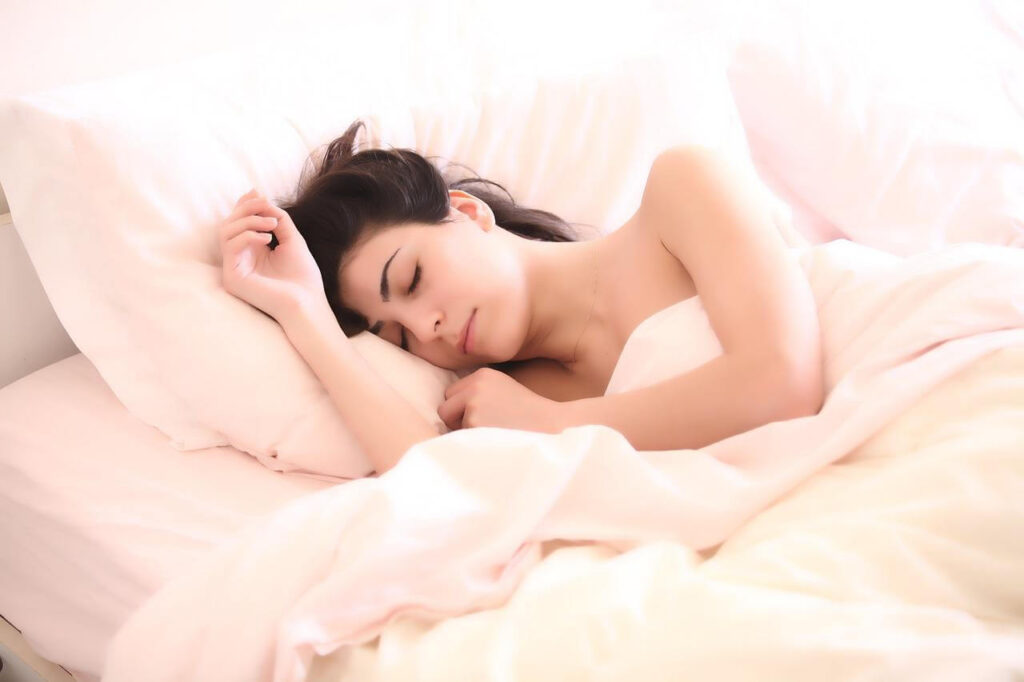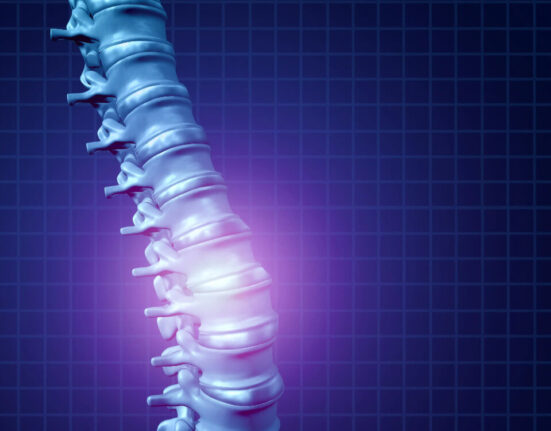Back pain can be a debilitating condition that affects your quality of life. One of the most effective ways to manage and prevent back pain is by ensuring your spine is properly decompressed during sleep. This article will explore natural methods to achieve spinal decompression while you rest, helping you wake up refreshed and pain-free.
Key Takeaways:
Learn the importance of proper sleeping posture for spinal health.
Discover mattress and pillow types that aid in spinal decompression.
Understand the role of stretching and relaxation techniques before bed.
You are not alone
A majority of the population suffers from backpain, and managing it is key.
Percentage of males and females suffering from back pain across different age groups

What Is Spinal Decompression?
Spinal decompression is a crucial process that allows our spine to stretch and relax, relieving pressure and promoting overall spinal health. It involves creating space between the vertebrae, the small bones that make up our spine, to alleviate compression on the discs, nerves, and other structures in the back.
In simpler terms, think of spinal decompression as giving your spine a gentle stretch and rest, similar to how we stretch our muscles after a long day. This stretching helps to release any tension or tightness that may have built up in our spine, allowing it to rejuvenate and function optimally.

The spine features spongy material between each vertebra, known as intervertebral discs, which serve as cushions and enable smooth movement of the spine. Proper decompression is essential to alleviate pressure on these discs, allowing them to rejuvenate and maintain optimal functionality.
This natural process of decompression is like giving our spine a chance to breathe and reset, and it’s essential for keeping our backs happy and healthy. Whether you’re a grown-up or a child, it’s important to understand that taking care of our spine through decompression can help us feel better and move more freely, especially when we wake up in the morning.
The Importance of Spinal Decompression
The spine is a complex structure made up of vertebrae, discs, nerves, and supporting muscles. During the day, gravity and daily activities compress the spine, which can lead to discomfort or pain. Decompressing the spine while sleeping gives it a chance to rest and rejuvenate. Proper spinal alignment during sleep can prevent the exacerbation of back pain and promote healing of the spinal tissues.
Dr Mandell shows you an effective stretch position you can do in bed to decompress your spine and alleviate pain.
Choosing the Right Mattress
A mattress that provides the right balance of support and comfort is crucial for spinal decompression. A medium-firm mattress is often recommended as it supports the natural curvature of the spine while providing enough cushioning for pressure points.
Memory foam and latex mattresses are popular choices as they contour to the body’s shape and reduce the risk of misalignment. It’s essential to replace your mattress every 7-10 years or when it starts to sag, as an old mattress can contribute to poor spinal alignment.
7 Additional points and tips to consider when choosing a mattress for spinal decompression
1. Adjustable Beds
Consider using an adjustable bed frame that allows you to elevate the upper and lower body, which can help in relieving pressure on the spine and promoting better sleep posture.
2. Pillow-Top Mattresses
A pillow-top mattress can provide an extra layer of cushioning, which may be beneficial for individuals seeking additional comfort and support for spinal alignment.
3. Body Weight Consideration
Individuals with different body weights may require varying levels of mattress firmness. For instance, heavier individuals might benefit from a slightly firmer mattress to prevent excessive sinkage, while lighter individuals may find a medium-firm mattress more suitable.
4. Trial Period
Look for mattresses that come with a trial period, allowing you to test the mattress at home and ensure it adequately supports your spine and promotes comfortable sleep.
5. Professional Advice
Consult with a healthcare professional, such as a chiropractor or orthopedic specialist, to get personalized recommendations based on your specific spinal health needs.
6. Maintenance
Regularly flipping or rotating the mattress can help maintain its integrity and prevent uneven wear, contributing to better spinal support over time.
7. Budget
While quality mattresses are an investment in spinal health, it’s important to set a budget and explore options that strike a balance between affordability and the features necessary for spinal decompression.
The Role of Pillows in Spinal Health
Pillows are not just for comfort; they play a significant role in maintaining spinal alignment. The right pillow will keep your head and neck aligned with your spine. A cervical pillow, designed to support the contours of your neck, can be particularly beneficial. For side sleepers, a pillow between the knees can help maintain hip alignment and further reduce spinal strain.

Optimizing Sleep Environment for Spinal Health
Creating an optimal sleep environment is crucial for those wondering how to decompress the spine while sleeping. The bedroom should be a sanctuary that promotes relaxation and, consequently, spinal health.
Ensure that the room temperature is comfortable – not too hot or too cold – as extreme temperatures can lead to restless sleep and increased tension in the back muscles.

A tranquil environment can significantly improve sleep quality, allowing the spine to rest and decompress naturally throughout the night.
The arrangement of the bedroom furniture can influence your ability to decompress your spine while sleeping. The bed should be positioned in a way that allows for easy access, without the need to twist or bend awkwardly to get in or out.
Keep the area around your bed clear of clutter to prevent any accidents that might jar the spine. Investing in a good quality bed frame that provides sturdy support can also make a difference. A stable base ensures that the mattress performs optimally, contributing to a night of restorative sleep and spinal decompression.
Incorporating Spinal Decompression Exercises Before Bed
Incorporating spinal decompression exercises before bed can be a game-changer for those seeking how to decompress the spine while sleeping.
Gentle, low-impact exercises such as:
Pelvic Tilts

Knee To Chest Stretch


Performing these exercises for a few minutes each night can prepare your body for a restful sleep, allowing the spine to decompress and heal from the day’s stresses.
Always ensure that you execute these movements with proper form and breathing to maximize their decompressive effects.
Additionally, consider incorporating a routine that includes yoga or Pilates, which are known for their spine-lengthening and strengthening benefits.
These stretches specifically improve spinal alignment by targeting the back
1. Cat-cow stretch

Downward-facing dog (dog optional)

Pigeon Pose
These practices not only help in decompressing the spine but also promote flexibility and core strength, which are essential for maintaining spinal health. By making these exercises a regular part of your pre-sleep routine, you can enhance your spine’s ability to decompress naturally during sleep.
Sleeping Positions for Spinal Decompression
Your sleeping position can significantly impact spinal health. The best positions for decompression are on your back or side. Back sleepers may benefit from placing a pillow under their knees to maintain the spine’s natural curve. Side sleepers should aim to keep their spine straight by using a supportive pillow and placing a pillow between their knees.
The Impact of Lifestyle on Spinal Health
Lifestyle factors such as weight, physical activity, and ergonomics can affect spinal health. Maintaining a healthy weight reduces the load on the spine, while regular exercise strengthens the muscles that support it.
Proper ergonomics, especially if you spend long hours sitting, can prevent excessive spinal compression during the day, making it easier to decompress at night.
When to Seek Professional Help
If you consistently wake up with back pain despite trying these methods, it may be time to consult a healthcare professional. Persistent back pain can be a sign of an underlying condition that requires medical attention. A professional can provide a tailored plan to address your specific needs and may recommend therapies such as physical therapy or chiropractic care.
Summary of how to decompress the spine while sleeping
Decompressing the spine while sleeping is a natural and effective way to prevent and alleviate back pain. By choosing the right mattress and pillow, practicing pre-sleep stretching and relaxation, adopting proper sleeping positions, and considering lifestyle factors, you can improve your spinal health and overall well-being. Remember to seek professional advice if your back pain persists.
FAQ Section
Q: How often should I replace my mattress to ensure proper spinal decompression?
It’s recommended to replace your mattress every 7-10 years or when it starts to show signs of wear, such as sagging, which can affect spinal alignment.
Q: Can the type of pillow I use really affect my spine?
Yes, using the right pillow is crucial for maintaining the natural alignment of your spine. A cervical pillow or a pillow that supports the neck and head can prevent strain on the spine.
Q: What if I still experience back pain after following these tips?
If you continue to experience back pain, it’s important to consult a healthcare professional. Persistent back pain may indicate an underlying condition that requires a specialized treatment plan.
The links used on thewellthieone.com are affiliate links, which may provide a small commission. This does not increase the price of the goods for the consumer whatsoever. What it does is ensure that useful content like this can continue to be produced. Thank-you for enjoying our content and allowing us to continue to provide more.







